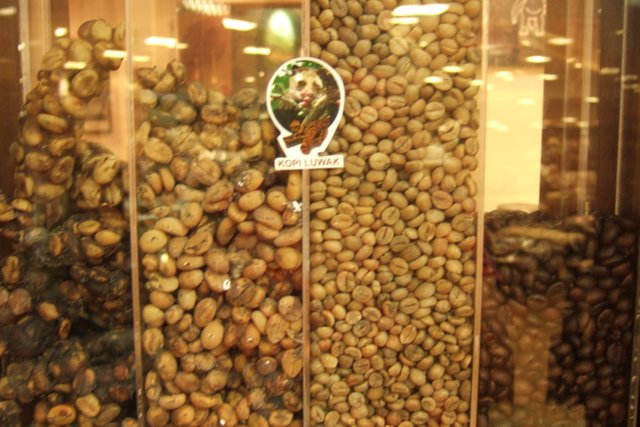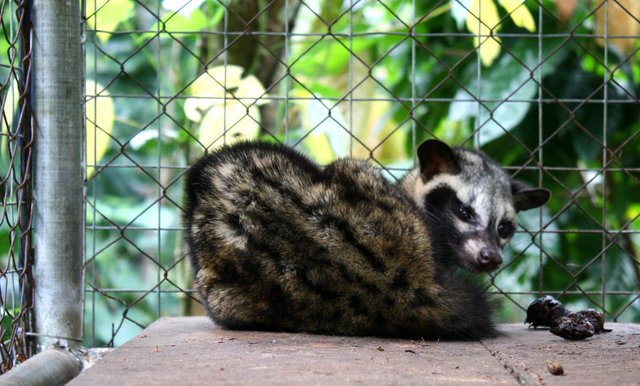The most expensive one – Kopi Luwak
For 35 to 90 US$ a cup (or 500 to 800 US$ a pound) you can buy “real” Kopi Luwak coffee. This probably would be by far the most expensive cup you will ever have. Of course it is rare and scarce (production is probably less than 5,000 pounds per year), but its most remarkable feature is that it is found in the poop of the Asian palm civet. Yes, the coffee beans are found in the droppings of that animal, cleaned, processed and sold.

“Kopi” is the Indonesian word for coffee and “Luwak” is the Indonesian name for an animal, found in Southeast Asia and sub-Saharan Africa. It has a long tail like a monkey, face markings like a raccoon and stripes or spots on its body. Sometimes it is also referred to as the “Civet Cat” although it is not feline.
It is said that this coffee was discovered in Indonesia during the colonial time when farmers and plantation workers were forbidden from harvesting coffee for their own use. However, they could find these droppings in the bush with coffee beans in them. Later they found out that the luwak eats coffee cherries and excretes the beans. They used those beans to make their coffee and the result was an exceptional good coffee (for that time). The luwak only eats ripe coffee beans and there is a natural “washing” process (like wet-milling) resulting in uniformly ripe coffee cherries being processed in a natural way by the animal’s digestive process that makes a smooth coffee with little acidity.
In those days, and well into the 20th century, well processed beans from selected coffee cherries were unknown, or at least very uncommon, so it would have been an appreciably better coffee than the usual ones you could get. Until today, this notion still exists and there are people who attribute some special effects to the digestive process that takes place inside the animal, some sort of unknowable animal magic.
Nowadays, as we know (and have learned) a lot more about coffee and the market is a lot more insistent upon quality, selective picking during harvest and quality processing and sorting are a lot more common than in those days. We often know about what variety was used, types of soils, altitude, location and type of processing of the coffee we buy. Quality standards for specialty coffees and certification are quite high. By today’s standards, Kopi Luwak coffee does not compare to other specialty coffees. Experts claim this coffee tastes quite ordinary and not very special, but there are other opinions as well. But the myth was created (and still exists), people heard about it and were willing to pay a lot for it, leading to exorbitant prices for this coffee. It has become a coffee for snobs.

And where there is money to be made … crooks show up. Sales level has risen to about 50 times above (possible maximum) production level, meaning that over 90% of coffee sold as Kopi Luwak is fake and hasn’t even been near a civet cat. And, can you imagine all those people running through the bushes near coffee farms looking for the civet cat’s droppings, knowing that they’re nocturnal, solitary, live in the rainforest and like to eat a lot of things? Wouldn’t it be easier to just fake it, or even better, kind of industrialize it? That is exactly what happened. Kopi Luwak production facilities have appeared throughout South-east Asia. I will not bother you with horror stories about caged luwaks but just show a quote from the Guardian:
“The naturally shy and solitary nocturnal creatures suffer greatly from the stress of being caged in proximity to other luwaks, and the unnatural emphasis on coffee cherries in their diet causes other health problems too; they fight among themselves, gnaw off their own legs, start passing blood in their scats, and frequently die.”
Tony Wild, The Guardian
The outrageous prices paid for real Kopi Luwak (up to US$3,200 per pound!) have led to even stranger things: you can find coffees treated with natural enzymatic simulation of the digestive process of the civet cat for example. And what to think of other animals used like washing machines and producing poop coffees: elephants (black ivory coffee from Thailand), monkeys, goats, birds (the jacu bird coffee from Brazil), and last but not least, human poop coffee.
It’s difficult for me to write a negative story about a coffee and it is not fair to the honest, hardworking bona fide producers, but I would never buy this coffee (even if I could afford it). However, if I were to make a trip to South-east Asia and could find the real thing .. I just would love to try it out!
Previous article from coffee series you can find under tag #cafescope.
You can see them all here.
Article was also published on Cafescope
Congratulations @petrvl! You have completed the following achievement on the Steem blockchain and have been rewarded with new badge(s) :
Click here to view your Board of Honor
If you no longer want to receive notifications, reply to this comment with the word
STOPDo not miss the last post from @steemitboard: